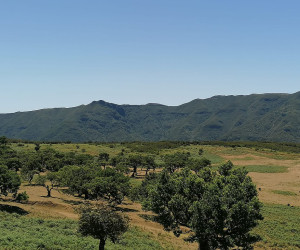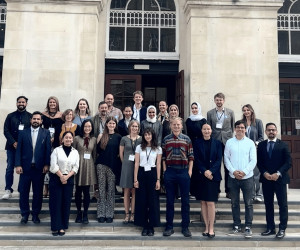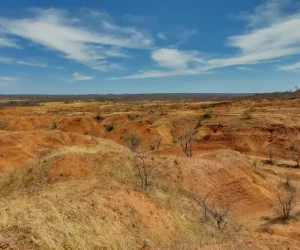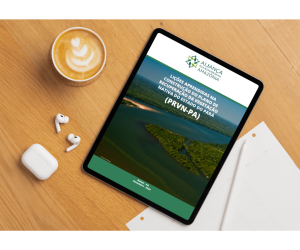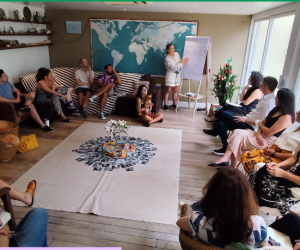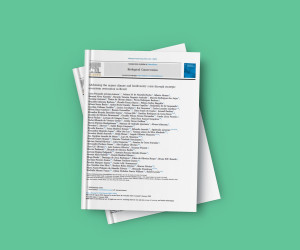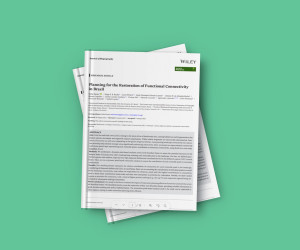News > News
23.08.19
IIS and BPBES launch Summary for decision-makers of the thematic report “Landscape and Ecosystem Restoration”
Study shows socio-economic and environmental benefits of integrated landscape planning that combines agricultural production, conservation and restoration; In addition to reversing degradation, the process increases climate resilience, ensures the presence of pollinators – increasing national agricultural productivity by up to 90% – and also provides timber products, fruits and forest bioactive products that diversify the market and generate income for landowners.
Rio de Janeiro, August 23, 2019 – The Brazilian Platform for Biodiversity and Ecosystem Services (BPBES) and the International Institute for Sustainability (IIS) launch today the summary for decision makers of the thematic report “Landscape and Ecosystem Restoration”. Prepared by 45 researchers from 25 institutions, the study brings together scientific knowledge on initiatives, practices and public policies aimed at more sustainable land use in Brazil, contributing directly to the mitigation of climate change and the achievement of global goals. The objective is to inform government, business and other managers and leaders, from the public and private spheres, about the best way to go.
Given the growing alteration of natural environments by human activities, the restoration of landscapes and ecosystems has become a priority internationally. So much so that the United Nations (UN) declared the period between 2021 and 2030 as the Decade on Restoration of Ecosystems. And, amid a critical juncture for the Brazilian environmental agenda, the BPBES and IIS document presents data and proposals to demonstrate the mutual benefit between agricultural production, conservation and restoration. The study is being launched in due course: two weeks after the UN Intergovernmental Panel on Climate Change (IPCC) released a special report that addresses the relationship between land use and climate change, warning of the importance combat deforestation, protect natural ecosystems and promote the recovery of native vegetation.
Brazil has lost 70 million hectares of native vegetation in the last 30 years. For the most part, they are abandoned, misused, eroding lands that add little to the country. “These areas do not contribute to food production, any other economic activity, or ecosystem services. Restoring it should be a national priority! ”Points out Bráulio Dias, professor at UnB and former executive secretary of the UN Convention on Biological Diversity. The study notes that each biome and its level of degradation require specific ecological restoration methods to ensure the most cost-effective, and details the most appropriate techniques for each area, including conducting natural regeneration.
Synergy and interdependence – According to the document, restoration of landscapes and ecosystems does not compete with agricultural activities; on the contrary, they are synergistic actions. The report coordinator, Renato
Crouzeilles, professor at the UFRJ Graduate Program in Ecology and the Rio Conservation and Sustainability Science Center at PUC-Rio and associated with IIS, points out that science and politics go hand in hand and benefit. “Intelligent planning and integrated landscape management lead to a win-win situation, where the environment wins, agricultural production wins and society wins,” he explains.
In the same vein, Ricardo Rodrigues, professor at Esalq / USP, where he coordinates the Laboratory of Ecology and Forest Restoration (Lerf), and also one of the study’s coordinators, argues that agriculture and environment are not competing, but interdependent. Therefore, they must be approached jointly, from the perspective of ‘environmental and agricultural adequacy of rural properties’, a concept that has been practiced for more than 20 years at Lerf, resulting in environmental and productive benefits. To this end, he argues that scientific knowledge needs to come closer to society and society should better appropriate this knowledge. “We have to break this barrier. We cannot continue to generate quality knowledge for ourselves by discussing among peers. I believe this study is an interesting instrument for this approach. ” For Rodrigues, the differential of Brazilian agriculture should be the latest technology, high productivity and low environmental impact, in an environment rich in biodiversity and, therefore, with environmental and socioeconomic sustainability.
For this to happen, Crouzeilles believes it is essential to raise government awareness of the synergy between the environment and agriculture, which can lead to better environmental, economic and social quality, vital to tackling climate change. “Restoration is the nature-based solution with the greatest potential to mitigate the effects of climate change, which, if not tackled now and with intensity, will lead to the loss of agricultural productivity, greater social and economic inequity and the destruction of natural
Bernardo Strassburg, PUC-Rio professor, IIS executive director and document coordinator, also underscores the enormous potential of ecological restoration to contribute to the attainment of multiple Sustainable Development Goals in a cost-effective manner. “In addition to the Goals related to biodiversity conservation and climate change mitigation and adaptation, restoration can significantly support the goals associated with food, water and energy security, poverty reduction, job creation and sustainable production and consumption.”
According to the report, restoration of landscapes and ecosystems ensures the presence of pollinators, which increase the productivity of Brazilian agricultural crops by up to 90%. “About 40% of the country’s agricultural crops have a 40-100% reduction in production in the absence of pollinators, and in another 45% of crops, the decrease is between 1-40%,” says the text. According to the study, if well planned and implemented in the landscape, restoration can increase biodiversity conservation by over 200%.
Socioeconomic Benefits – In addition to reversing environmental degradation and restoring ecosystem functionality, the recovery of native vegetation also provides economic opportunities for inclusion and reduction of social inequalities. “It is estimated that 200 direct jobs will be created (through seed collection, seedling production, planting and maintenance) per 1,000 hectares under human intervention restoration. Depending on the balance between recovery with high human intervention and conducting natural regeneration, it is projected that between 112 and 191 thousand jobs will be generated annually by 2030 to reach the Brazilian target of 12 million hectares of native vegetation ”, details the document.
The text goes on to explain that restored areas, in addition to providing pollinators for surrounding crops, also offer timber products, fruits and bioactives of native vegetation under restoration, which diversify local markets and benefit society as a whole, but are especially important. for income generation to landowners. “If you restore ecosystems in degraded areas that give no economic return, the supply of food will increase because food comes not only from farming, it also comes from rivers, through fishing, and from the forest where you can reap a fruit. or a root. This will improve food security, ”says Bráulio Dias.
Engagement and citizenship – Several movements, which bring together social actors involved in restoration initiatives, have created governance, communication and articulation mechanisms, monitoring systems and strategies to influence public policies. Some of the main examples in Brazil are the Atlantic Forest Restoration Pact, the Amazon Restoration Alliance and the Xingu Seed Network. The authors point out that these collectives have also given special attention to the issue of gender and race diversity.
In Crouzeilles’ view, awareness and engagement are essential for a conscious society, with actions in all spheres of influence. “To this end, governments, states, researchers, practitioners, and restorative collectives must disseminate science-based knowledge throughout society, from the rural to the urban population. Regardless of the environmental public policies pursued by the government, everyone must continue to do their part so that there is environmental and socioeconomic gain in the country, ”he adds.
Rodrigues points out that, contrary to the current political agenda, the only way around the setbacks is to exercise the citizen role and demand a higher quality of our agricultural products. He points out that we still do not have instruments that inform the consumer about the origin of these products. “We do not know if it respects environmental legislation, if it complies with the principles of equal pay for men and women, and whether it combats slave labor, for example. If we give preference to products with environmental and socioeconomic certification, we will change the market by default, ”he suggests. Gaining Scale – For Dias, one of the biggest challenges facing Brazil is gaining scale in ecosystem restoration efforts. “The country has technical and academic skills, subject matter experts, manuals and experience on what works and what doesn’t. We now have to get out of local initiatives and start to recover on a national scale. This requires public policy and private sector engagement, and I believe this report is a great contribution to convincing decision makers, ”he says. Carlos Joly, BPBES coordinator and professor at Unicamp, points out that the country has the opportunity to develop a unique native vegetation recovery program. “We have enough knowledge to use a high number of native species, especially in the Atlantic Forest. The study points out that restoration can be done in the areas with the best cost versus species diversity and ecosystem services.
In addition to soil protection and stability services, with the reduction of surface erosion, and the protection of water resources, thanks to the reduction of siltation, ”he says. The text presents the eight pillars necessary to enable the large-scale and cost-effective recovery of native vegetation in Brazil, identified during the process of drafting the National Plan for Native Vegetation Recovery, the basic instrument of the National Vegetation Recovery Policy. Native And, on the other hand, the authors highlight at least 10 priority actions to counteract the gaps that still hinder a concrete scale gain in restoration initiatives associated with sustainable and high productivity agricultural production in integrated landscape management approaches.
“Brazil and its farmers have much to gain by being the protagonists of a transition to more sustainable land use, with zero illegal deforestation, intensified and sustainably technified agricultural production and, at the same time, associated with the large-scale recovery of native vegetation. ”Says the document.
Environmental role and global context – On the international scene – especially in the European Union – there is a growing demand for imports of sustainable agricultural products that do not degrade the environment or compromise the quality of life of the population. “Brazil must also follow this path, otherwise there is a great chance of suffering international embargoes on its agricultural products. The world is together for the Restoration Decade and, if we can continue with the environmental protagonism of recent years, Brazil has everything to consolidate itself as an environmental leader and active voice throughout this decade. This will bring even more investment and recognition to the country, ”says Crouzeilles.
For the opportunities to come true, the report points out that the country cannot backtrack on its environmental policies of reducing deforestation, conserving biodiversity and boosting the recovery of native vegetation on a large scale. The end of the legal reserve obligation, the reduction of the alternatives of fines conversion and the extinction of the collaboration and coordination forums between government and society actors would be irreparable losses for an environmental adequacy policy. “Brazil has assumed the role of leader in international environmental negotiations and any disruption of this path, besides removing opportunities, will drive away international markets that consume agricultural products. This is because, increasingly, they are guided by sustainable production and consumption, including policies of non-consumption of products from deforested areas, such as the soy moratorium in the Amazon, ”warns the study.
Watch the video at the link below and learn about the socioeconomic and environmental benefits of integrated landscape planning that combines agricultural production, conservation and restoration; in addition to reversing the degradation.
Download the sumary and report here: https://www.bpbes.net.br/produto/restauracao

